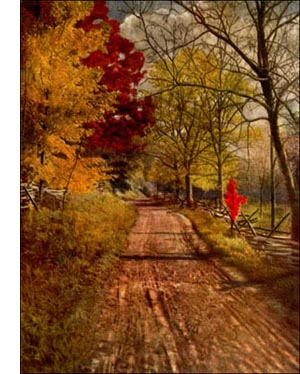Bur Oak or Mossy Cup Oak Tree
 Bur or Mossy-cup Oak (Quercus macrocarpa, Michx.)-A large tree, 75 to 160 feet high, with spreading branches, and irregular, round head. Bark greyish brown, deeply furrowed, becoming scaly; branches roughened with thick, corky ridges; twigs winged or smooth, stout, and pubescent at first. Wood brown, with paler sap wood, close grained, heavy, hard, durable in soil; medullary rays conspicuous. Buds small, blunt pointed, pubescent. Leaves obovate, alternate, 6 to 12 inches long, 3 to 6 inches wide, 5 to 7-lobed; sinuses rounded, shallow or deep, middle ones often wider, opposite and nearly reach the midrib; petioles short, grooved; summer colour lustrous dark green, with pale, or silvery pubescent lining; autumn colour yellow or brown. Flowers with half-grown leaves in May; staminate in hairy yellow catkins; pistillate, with hairy red scales and bright red stigmas. Acorns annual, 1/2 to 2 inches long, ovoid, variable in size and shape, pubescent, in deep (rarely shallow) cup, brown, hairy, with loose scales and mossy fringe. Kernel white, sweet. Preferred habitat, rich, well-drained soil. Distribution, Nova Scotia to Montana; south to Pennsylvania, Tennessee and Texas. Uses: Same as Q. alba. Picturesque park tree. Easily transplanted when young.
Bur or Mossy-cup Oak (Quercus macrocarpa, Michx.)-A large tree, 75 to 160 feet high, with spreading branches, and irregular, round head. Bark greyish brown, deeply furrowed, becoming scaly; branches roughened with thick, corky ridges; twigs winged or smooth, stout, and pubescent at first. Wood brown, with paler sap wood, close grained, heavy, hard, durable in soil; medullary rays conspicuous. Buds small, blunt pointed, pubescent. Leaves obovate, alternate, 6 to 12 inches long, 3 to 6 inches wide, 5 to 7-lobed; sinuses rounded, shallow or deep, middle ones often wider, opposite and nearly reach the midrib; petioles short, grooved; summer colour lustrous dark green, with pale, or silvery pubescent lining; autumn colour yellow or brown. Flowers with half-grown leaves in May; staminate in hairy yellow catkins; pistillate, with hairy red scales and bright red stigmas. Acorns annual, 1/2 to 2 inches long, ovoid, variable in size and shape, pubescent, in deep (rarely shallow) cup, brown, hairy, with loose scales and mossy fringe. Kernel white, sweet. Preferred habitat, rich, well-drained soil. Distribution, Nova Scotia to Montana; south to Pennsylvania, Tennessee and Texas. Uses: Same as Q. alba. Picturesque park tree. Easily transplanted when young.The bur oak is a rugged-looking tree, more picturesque than its near relative, the white oak, which is conventional and symmetrical when it has its own way in growing. The bur oak flings out its antlered arms without regard for balance and symmetry, and casts off the bark of its shaggy limbs with utter indifference to any law of neatness. Broad corky wings are seen even on young twigs, and these are stout and curiously gnarled.
The leaves are of unusual length and deeply cut into irregular fingers, or broader lobes. Often two opposite sinuses, wider than the rest, almost cut the leaf in two in the middle. Bright and shining above, these leaves are woolly lined and thick.
The acorns are very striking in appearance. The brown nut is often 2 inches long and set in a thick, hairy cup, covered with coarse, pointed scales. that become elongated toward the rim, and form a loose, fringed border. The nut is half covered by the cup as a rule. Sometimes it is quite swallowed up in it. From this the species is sometimes, but erroneously, called the overcup oak.
This tree is one of the most widely distributed and valuable of North American oaks. It has an astonishing power of adaptation to different regions and climates. It grows from Nova Scotia to western Texas; there are forests of it in Winnipeg; it forms the "oak openings" of Minnesota and Dakota. It seems as much at home in the hot and arid stretches of the West and Southwest as in the cold, damp air of the coast of New England, or the fertile valley of the Ohio, where it reached nearly 200 feet in height in the virgin forests.
The sturdiness of the bur oak, its rapid growth in good soil, its rugged picturesqueness, winter and summer, all commend it to planters. It is one of the most ornamental of American oaks in cultivation; and the raising and transplanting of it are fairly easy. People who do not plant oaks because they take so long to become big trees miss much pleasure they have not counted on. It may be children's children who see the aged, tree, beautiful in its expression of massiveness and rugged strength. But the planter enjoys the grace of the sapling, the rich foliage of the young tree which is always larger than on the old ones; and there is very early seen in any bur oak the stocky build and the shaggy bark that mark the adult tree. It grows rapidly, and soon blossoms and fruits freely. Every year shows gains, and the cycle of the year in the treetop is worthy of close attention.
The wood of white oaks is of highest quality, the English oak itself being one of this group. The bur oak is counted even better than that of Quercus alba, when grown in rich soil. The planting of bur oaks on the prairie is especially recommended by those who understand the conditions prevailing there. It is grown for shade and for lumber.